The Nauarchos (or Navarchos) Miaoulis was an unprotected Greek masted cruiser ordered in France 1877, decommissioned in 1931. The Greek Ναύαρχος was a very old naval rank corresponding to Admiral, named for the admiral Andreas Miaoulis, leader of the Greek rebels fleet in the Greek War of Independence between 1821 and 1829. She was designed as a 1820 tons unprotected master cruiser for fleet operations, acting as scout and deployable for independent operations against the Turks if required. Built at Forges et Chantiers de la Méditerranée (FCM) from 1878, she was launched in 1879 and commissioned the same year. However she was soon made obsolete and used as training ship when WWI broke out. Despite her venerable age she was only decommissioned in 1931.
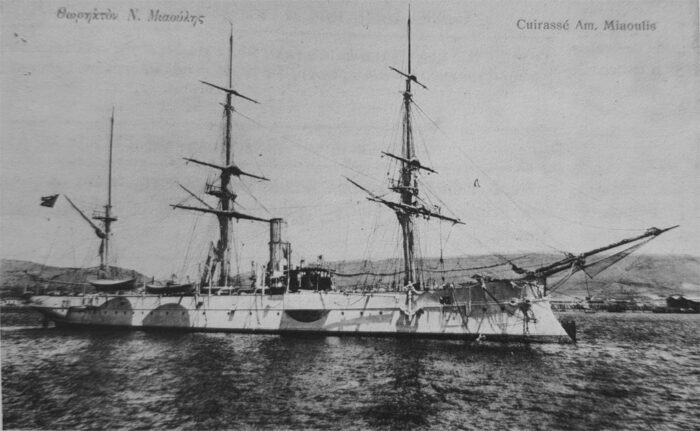
About Admiral (Navarchos) Andreas Vokos Miaoulis:
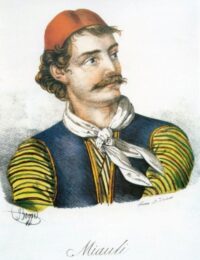 Miaoulis was born on Hydra island, to Arvanite family of Euboean origin from Fylla. Miaoulis became a trader in corn who which became wealthy and a merchant captain after purchasing his own ship, and led the naval forces of the islands when the insurrection started against the Sultan. Miaoulis saw his business in wheat-shipping flourishing in the Napoleonic Wars and between May 1825 and January 1826, her led the Greeks to victory off Modon, Cape Matapan, Suda, and Cape Papas at the head of a small fleet he financed in part himself.
Miaoulis was born on Hydra island, to Arvanite family of Euboean origin from Fylla. Miaoulis became a trader in corn who which became wealthy and a merchant captain after purchasing his own ship, and led the naval forces of the islands when the insurrection started against the Sultan. Miaoulis saw his business in wheat-shipping flourishing in the Napoleonic Wars and between May 1825 and January 1826, her led the Greeks to victory off Modon, Cape Matapan, Suda, and Cape Papas at the head of a small fleet he financed in part himself.
In 1822 he was appointed navarch at the head of small vessels in the insurgent fleet and led expeditions notably to avenge the massacre of Chios and won the Battle of Nauplia in September. In 1824, he commanded Greek forces by ambushing and defeating the reinforcement fleet. He harassed the Egyptian forces after occupying Navarino and in 1825 shipped supplies and reinforcements into Missolonghi (besieged). However the Egyptian forces were far superior. The growth of piracy in Eastern Mediterranean made their work even harder. He was succeeded eventually by Thomas Cochrane in 1827 and retired, but he saw independence obtained.
In in his old age he saw the civil was as opponent of Kapodistrias and the Russian Party and seized ships at Poros in August 1831, Hellas, and later destroyed them to avoid capture by the Russian fleet. He also led the delegation visiting King Otto to accept the crown of Greece. He was made rear-admiral and vice-admiral later by Otto and Grand Cross of the Order of the Redeemer. He died on 24 June 1835 at Athens, buried in Piraeus near the tomb of Themistocles. His son Athanasios became PM of Greece between 1857 and 1862 and a festival, called Miaoulute, takes place in Hydra yearly in June.
Design of the class
No profile
She was purchased as part of the national program of naval expansion after the failed Cretan uprising of 1866 due to the lack of naval support. Indeed as the 1866 blockade of the island established by Ottoman ships, the Greek kingdom only had armed merchant steamers, “Panelinion”, “Arkadi” and “Enosis”. They were worefully inadequate to face the might of the Ottoman fleet, boasting a number of ironclads and many frigates. This failure was seen as a national humiliation leading to seek for the private sector t finance a proper navy as the state budget was quite limited. A “tradition” reconducted before the Balkan war when Giorgios Averoff was ordered in Italy. Still, the small central battery ship Basilos Giorgios was ordered in Britain even prior to the war by was not launched before 1867. Next came the broadside ironclad Basilissa Olga built by STT in Austria, and the French Spetstai (or Hydra) class.
The same impetus led to order a first cruiser in 1877. Navarchos Miaoulis was ordered that year after a delegation sent in France visited FCM and enquired about the possibility to built a masted unprotected cruiser. For construction 2.3 million gold drachmas were raised by the “Society for the Establishment of a National Fleet” founded in 1866 by veteran and hero of the Greek Revolution, captain Constantis Nikodimos. This was the first contribution of the Society to the construction of the new fleet, later expanded to the Hydra class ironclads.
Her design was partly based on the serie of small unprotected cruisers of the 1877-82 Lapérouse and Villars class, but even smaller. She would be a 2nd rate unprotected cruiser, albeit the project was prepared by the then famous shipbuilding company Logan. For her era, she was beautiful ship with a sail area of 1,720 square meters (later reduced).
Hull and general design
The hull was made of iron and wood, with steel used only for the amidship section where the main guns were located. Albeit not armoured, this made this section stronger to resist at least some shrapnel and small arms fire. Displacement was 1,800 ton, 1820t in most sources. She was short, 246 feet long (75 meters) with a beam of 36 feet (11 meters) and a mean draught of 14’5″ or 4.40m. She had a prominent ram bow and some tumblehome customary for French ships of that era. She was barque-rigged cruiser, with three masts and the funnel located close to the mainmast amidship, sheathed and coppered.
Powerplant
She had a single propeller and its HDA counpound engine, possibly (by analogy) fed by the steam produced in four squarded one-ended boilers, coal firing. She produced 2,200/2,400 ihp for a contracted speed of 15 knots. In reality top speed was 13.5 knots on trials. Her autonomy in unknown but shecarried 220 tonnes coal and had her barque rigging, later reduced in service.
Armament
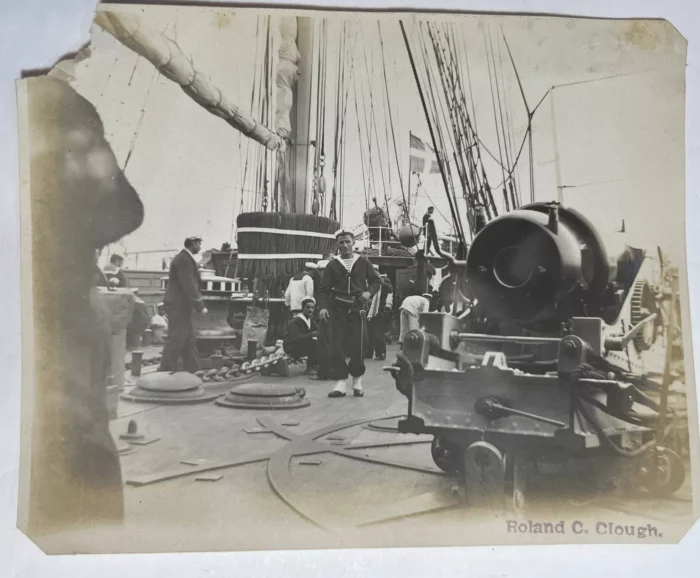
Miaoulis Main guns in 1910 src
Her armement was limited to what was best for her size.
-Three 6.7-inch (173 mm)/22 calibre RK L/25 C/74 guns in single mounts sides and aft
-One 6.7-inch (170 mm)/20 calibre gun 17 RK chasing gun
-Six 37 mm (1 in) 1-pounder guns in single mounts on the bridge wings and sides below the Lifeboats.
In the early 1890s, armament still comprised these three Krupp 17 cm RK L/25 in a single mounts, one 17 cm RK L/20 but two machine guns and four very light guns were added. It seems her main guns were never modernized but a greek source states she was armed with four 170 mm Kupp guns (likely the same, with the chase gun) but four 75 mm guns, possibly replacing the 37 mm light guns at some point.
⚙ specifications |
|
| Displacement | 1820 t standard |
| Dimensions | 75 x 11 x 4.4 m (246 x 36 x 14 ft) |
| Propulsion | 1 shafts Compound Engine, 4? boilers: 2,400 hp (1,800 kW) |
| Speed | 13.5 knot (25 km/h) |
| Armament | 3x 173mm Krupp, x 170mm, 4 x 37mm |
| Crew | 180 |
Career of Navarchos Miaoulis
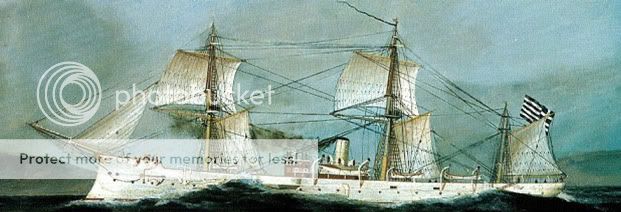
Navarchos Miaoulis was commissioned at the Chantiers de la Méditerranée in France after two years of construction. She was soon rendered operationally obsolete with the acquisition of the Spetsai class and was made later into a training ship until decommissioned in 1931. She was designated by the Greek Navy as a 2nd rate light cruiser. But after the construction of the battleships “Hydra”, “Spetses” and “Psara”, Navarchos Miaoulis quickly lost its importance for the Greek Navy.
1897 Moment of glory: Under command of Aristides Reinek , She prevented the Turks from landing troops in Crete. As Flagship of the 4th Squadron, under admiral K. Zotos, leading the flotilla, she sailed to intervene in support of the Cretan revolt from Ottoman rule and prevented the Turkish “Fonat” to land troops in Siteia, Crete. This was a success in the Cretan uprising in 1897-1898. The appearance of thes ships led to the rebels raising the Greek flag in the Chania suburb of Aleppo, declaring their attachment to Greece on 25 January 1897.
It seems that with the start of the Greco-Turkish War of 1897, she was reassigned to the Western (Ionian) Flotilla of Captain D. Kriezis.
After the war, she became training ship for midshipmen’s school and to show the flag in the Mediterranean and even touring Europe.
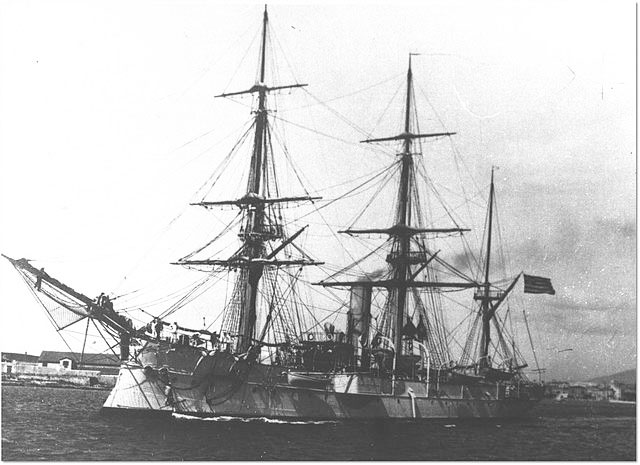
Atlantic Crossing: Until 1900 no Greek warship had ever sailed the Atlantic to reach the United States, which was accomplished by Miaoulis under command of Captain Palvos Koundouriotis (future admiral in 1912-13). She visited Boston and Philadelphia to gain US support and sailed home.
The Greek Navy will later indeed acquired US battleships in 1911, the Kilkis class.
She was stricken in 1912, hulked as gunnery training ship, then seamen’s training ship, unable to sail, and was finally sold for BU in 1931.
Read More/Src
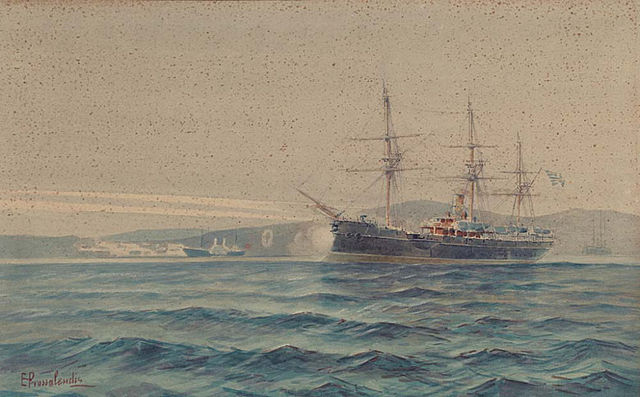
Books
Brassey’s Naval Annual. J. Griffin & Co, Portsmouth
Conway’s all the world’s fighting ships 1865-1905
TRIPONTIKAS, PANAGIOTIS; MILESIS, STEPHANOS (2015). 1900. Athens: FLOATING NAVAL MUSEUM THORIKTO “G.AVEROF”. page 320
Links
1900thebook.com/
greek-war-equipment.blogspot.com/
navypedia.org
cosmosphilly.com/
play.google.com/ brasseys
transportsofdelight.smugmug.com/
en.wikipedia.org/ Navarchos Miaoulis
Videos
None
Model Kits
None

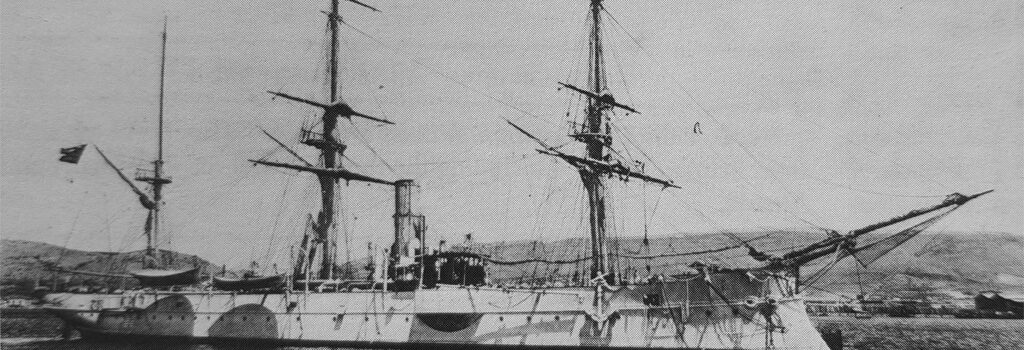

 Latest Facebook Entry -
Latest Facebook Entry -  X(Tweeter) Naval Encyclopedia's deck archive
X(Tweeter) Naval Encyclopedia's deck archive Instagram (@navalencyc)
Instagram (@navalencyc)





 French Navy
French Navy Royal Navy
Royal Navy Russian Navy
Russian Navy Armada Espanola
Armada Espanola Austrian Navy
Austrian Navy K.u.K. Kriegsmarine
K.u.K. Kriegsmarine Dansk Marine
Dansk Marine Nautiko Hellenon
Nautiko Hellenon Koninklije Marine 1870
Koninklije Marine 1870 Marinha do Brasil
Marinha do Brasil Osmanlı Donanması
Osmanlı Donanması Marina Do Peru
Marina Do Peru Marinha do Portugal
Marinha do Portugal Regia Marina 1870
Regia Marina 1870 Nihhon Kaigun 1870
Nihhon Kaigun 1870 Preußische Marine 1870
Preußische Marine 1870 Russkiy Flot 1870
Russkiy Flot 1870 Svenska marinen
Svenska marinen Søværnet
Søværnet Union Navy
Union Navy Confederate Navy
Confederate Navy Armada de Argentina
Armada de Argentina Imperial Chinese Navy
Imperial Chinese Navy Marinha do Portugal
Marinha do Portugal Mexico
Mexico Kaiserliche Marine
Kaiserliche Marine 1898 US Navy
1898 US Navy Sovietskiy Flot
Sovietskiy Flot Royal Canadian Navy
Royal Canadian Navy Royal Australian Navy
Royal Australian Navy RNZN Fleet
RNZN Fleet Chinese Navy 1937
Chinese Navy 1937 Kriegsmarine
Kriegsmarine Chilean Navy
Chilean Navy Danish Navy
Danish Navy Finnish Navy
Finnish Navy Hellenic Navy
Hellenic Navy Polish Navy
Polish Navy Romanian Navy
Romanian Navy Turkish Navy
Turkish Navy Royal Yugoslav Navy
Royal Yugoslav Navy Royal Thai Navy
Royal Thai Navy Minor Navies
Minor Navies Albania
Albania Austria
Austria Belgium
Belgium Columbia
Columbia Costa Rica
Costa Rica Cuba
Cuba Czechoslovakia
Czechoslovakia Dominican Republic
Dominican Republic Haiti
Haiti Hungary
Hungary Honduras
Honduras Estonia
Estonia Iceland
Iceland Eire
Eire Equador
Equador Iran
Iran Iraq
Iraq Latvia
Latvia Liberia
Liberia Lithuania
Lithuania Mandchukuo
Mandchukuo Morocco
Morocco Nicaragua
Nicaragua Persia
Persia San Salvador
San Salvador Sarawak
Sarawak Uruguay
Uruguay Venezuela
Venezuela Zanzibar
Zanzibar Warsaw Pact Navies
Warsaw Pact Navies Bulgaria
Bulgaria Hungary
Hungary

 Bundesmarine
Bundesmarine Dutch Navy
Dutch Navy Hellenic Navy
Hellenic Navy Marina Militare
Marina Militare Yugoslav Navy
Yugoslav Navy Chinese Navy
Chinese Navy Indian Navy
Indian Navy Indonesian Navy
Indonesian Navy JMSDF
JMSDF North Korean Navy
North Korean Navy Pakistani Navy
Pakistani Navy Philippines Navy
Philippines Navy ROKN
ROKN Rep. of Singapore Navy
Rep. of Singapore Navy Taiwanese Navy
Taiwanese Navy IDF Navy
IDF Navy Saudi Navy
Saudi Navy Royal New Zealand Navy
Royal New Zealand Navy Egyptian Navy
Egyptian Navy South African Navy
South African Navy






























 Ukrainian Navy
Ukrainian Navy dbodesign
dbodesign